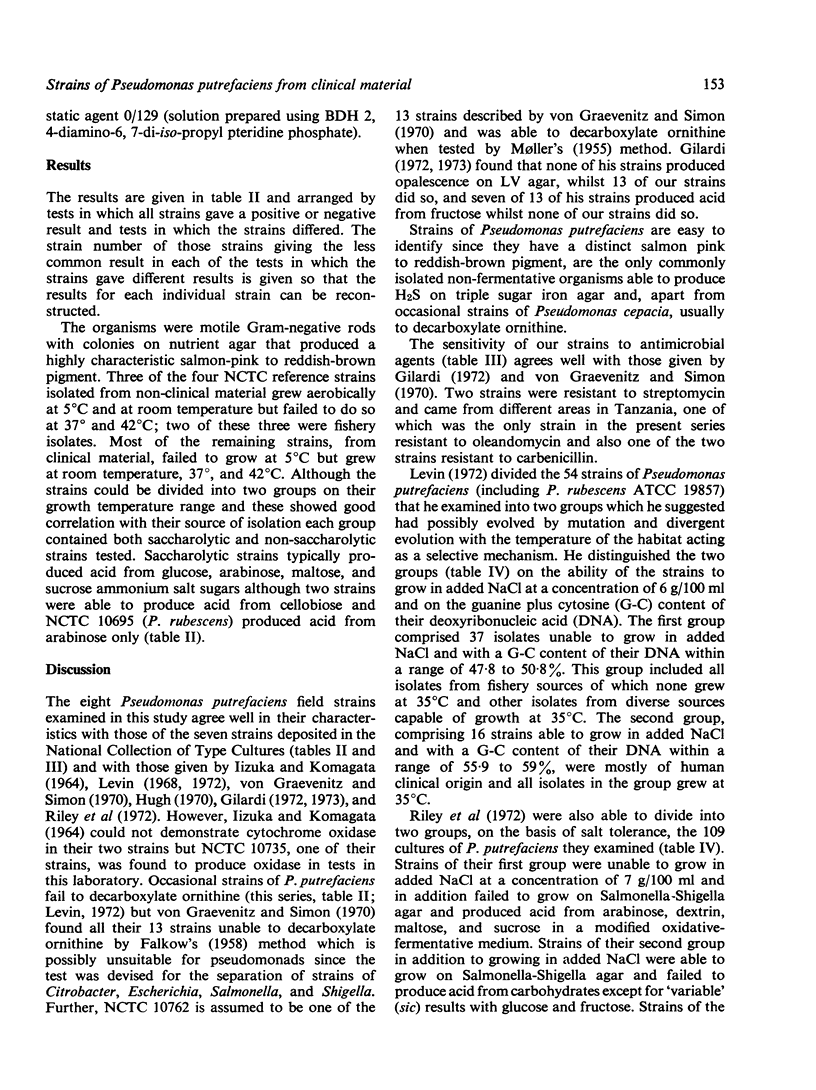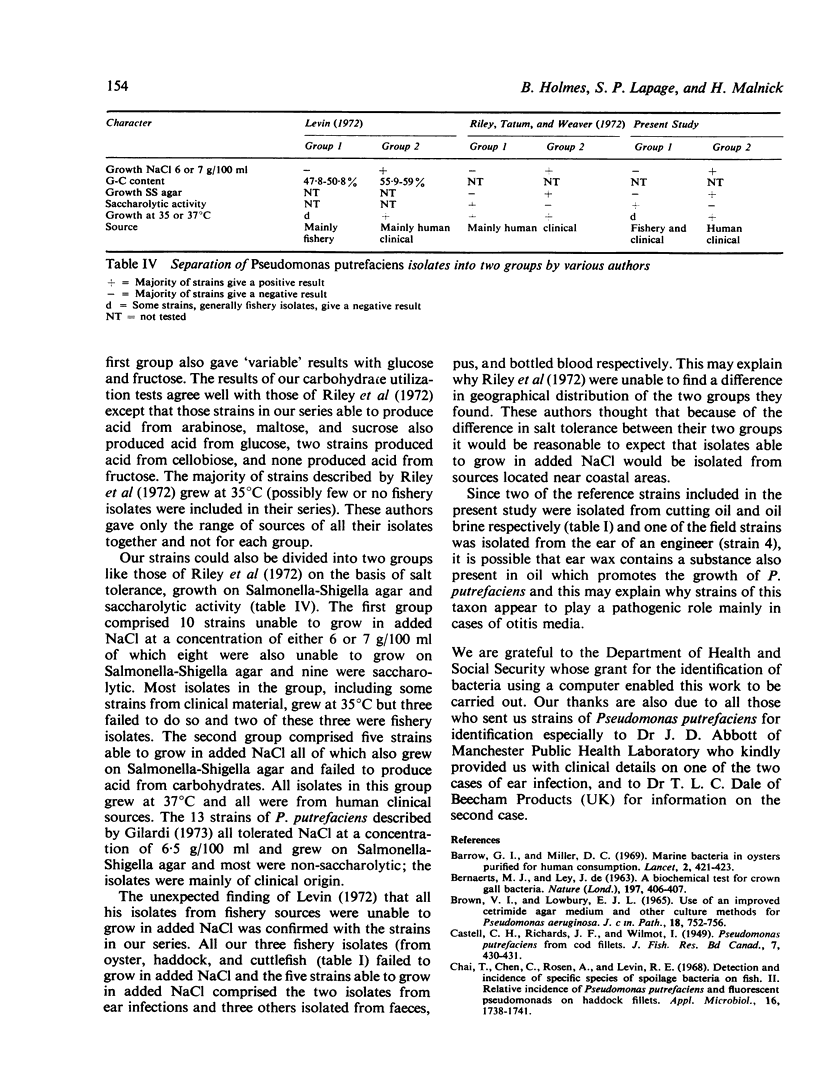Abstract
Eight strains of Pseudomonas putrefaciens have been received from among 466 strains of Pseudomonas submitted to the Computer Trials Laboratory for identification over the last eight years. Two of the strains of P. putrefaciens from patients with otitis media and otitis externa respectively appear to have played a pathogenic role. The biochemical characteristics of these eight strains were compared with those of seven culture collection strains.
Full text
PDF






Selected References
These references are in PubMed. This may not be the complete list of references from this article.
- Barrow G. I., Miller D. C. Marine bacteria in oysters purified for human consumption. Lancet. 1969 Aug 23;2(7617):421–423. doi: 10.1016/s0140-6736(69)90124-x. [DOI] [PubMed] [Google Scholar]
- Brown V. I., Lowbury E. J. Use of an improved cetrimide agar medium and other culture methods for Pseudomonas aeruginosa. J Clin Pathol. 1965 Nov;18(6):752–756. doi: 10.1136/jcp.18.6.752. [DOI] [PMC free article] [PubMed] [Google Scholar]
- Chai T., Chen C., Rosen A., Levin R. E. Detection and incidence of specific species of spoilage bacteria on fish. II. Relative incidence of Pseudomonas putrefaciens and fluorescent pseudomonads on haddock fillets. Appl Microbiol. 1968 Nov;16(11):1738–1741. doi: 10.1128/am.16.11.1738-1741.1968. [DOI] [PMC free article] [PubMed] [Google Scholar]
- FALKOW S. Activity of lysine decarboxlase as an aid in the identification of Salmonellae and Shigellae. Am J Clin Pathol. 1958 Jun;29(6):598–600. doi: 10.1093/ajcp/29.6_ts.598. [DOI] [PubMed] [Google Scholar]
- Gilardi G. L. Infrequently encountered Pseudomonas species causing infection in humans. Ann Intern Med. 1972 Aug;77(2):211–215. doi: 10.7326/0003-4819-77-2-211. [DOI] [PubMed] [Google Scholar]
- Gilardi G. L. Nonfermentative gram-negative bacteria encountered in clinical specimens. Antonie Van Leeuwenhoek. 1973;39(2):229–242. doi: 10.1007/BF02578855. [DOI] [PubMed] [Google Scholar]
- Lapage S. P., Bascomb S. Use of selenite reduction in bacterial classification. J Appl Bacteriol. 1968 Dec;31(4):568–580. doi: 10.1111/j.1365-2672.1968.tb00407.x. [DOI] [PubMed] [Google Scholar]
- Levin R. E. Correlation of DNA base composition and metabolism of Pseudomonas putrefaciens isolates from food, human clinical specimens, and other sources. Antonie Van Leeuwenhoek. 1972;38(2):121–127. doi: 10.1007/BF02328083. [DOI] [PubMed] [Google Scholar]
- Levin R. E. Detection and incidence of specific species of spoilage bacteria on fish. I. Methodology. Appl Microbiol. 1968 Nov;16(11):1734–1737. doi: 10.1128/am.16.11.1734-1737.1968. [DOI] [PMC free article] [PubMed] [Google Scholar]
- MØLLER V. Simplified tests for some amino acid decarboxylases and for the arginine dihydrolase system. Acta Pathol Microbiol Scand. 1955;36(2):158–172. doi: 10.1111/j.1699-0463.1955.tb04583.x. [DOI] [PubMed] [Google Scholar]
- Owens J. D., Keddie R. M. A note on the vitamin requirements of some coryneform bacteria from soil and herbage. J Appl Bacteriol. 1968 Sep;31(3):344–348. doi: 10.1111/j.1365-2672.1968.tb00376.x. [DOI] [PubMed] [Google Scholar]
- PIVNICK H. Pseudomonas rubescens, a new species from soluble oil emulsions. J Bacteriol. 1955 Jul;70(1):1–6. doi: 10.1128/jb.70.1.1-6.1955. [DOI] [PMC free article] [PubMed] [Google Scholar]
- Riley P. S., Tatum H. W., Weaver R. E. Pseudomonas putrefaciens isolates from clinical specimens. Appl Microbiol. 1972 Nov;24(5):798–800. doi: 10.1128/am.24.5.798-800.1972. [DOI] [PMC free article] [PubMed] [Google Scholar]
- SIERRA G. A simple method for the detection of lipolytic activity of micro-organisms and some observations on the influence of the contact between cells and fatty substrates. Antonie Van Leeuwenhoek. 1957;23(1):15–22. doi: 10.1007/BF02545855. [DOI] [PubMed] [Google Scholar]
- Schreier J. B. Modification of deoxyribonuclease test medium for rapid identification of Serratia marcescens. Am J Clin Pathol. 1969 Jun;51(6):711–716. doi: 10.1093/ajcp/51.6.711. [DOI] [PubMed] [Google Scholar]
- von Graevenitz A., Simon G. Potentially pathogenic, nonfermentative, H2S-producing gram-negative rod (1 b). Appl Microbiol. 1970 Jan;19(1):176–176. doi: 10.1128/am.19.1.176-176.1970. [DOI] [PMC free article] [PubMed] [Google Scholar]


